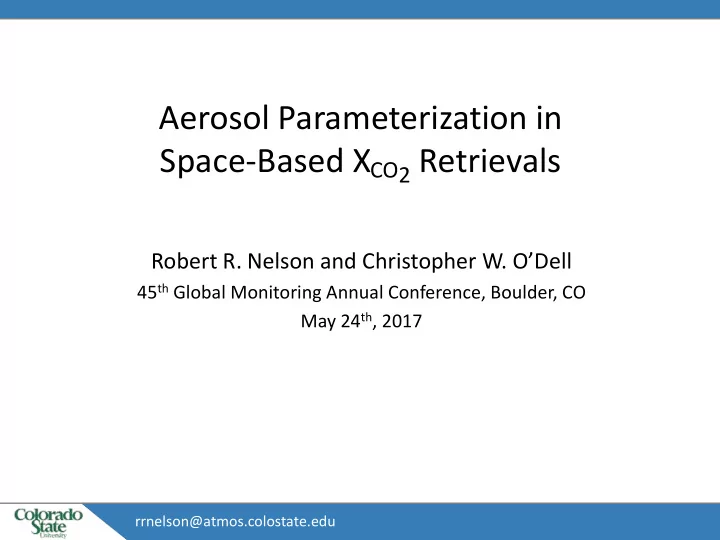

Aerosol Parameterization in Space-Based X CO2 Retrievals Robert R. Nelson and Christopher W. O’Dell 45 th Global Monitoring Annual Conference, Boulder, CO May 24 th , 2017 rrnelson@atmos.colostate.edu
• Carbon community wants accurate, non-biased OCO-2 X CO2 measurements • One of the largest sources of error in space- based measurements is the scattering effect of clouds and aerosols • How has this been handled in X CO2 retrievals? rrnelson@atmos.colostate.edu 2
Non-scattering retrieval Complexity • Ignoring clouds and aerosols proved ineffective 1 1 O’Brien and Rayner, 2002; Aben et al., 2007; Butz et al., 2009; Nelson et al., 2016 3
• Thus, methods of adding one or more scattering particles were developed 2 • Try to retrieve information about amount, optical properties, and/or location in the atmosphere 2 Butz et al., 2009; Yokota et al., 2009; Crisp et al., 2010; Reuter et al., 2013; Parker et al., 2011 4
Non-scattering retrieval OCO-2 B7 Complexity • Current OCO-2 operational algorithm retrieves 8 parameters • Optical depth and height of 4 types – Ice cloud, water cloud, 2 aerosols from a MERRA-2 monthly climatology rrnelson@atmos.colostate.edu 5
Non-scattering retrieval OCO-2 B7 OCO-2 B8 Complexity • Latest non-operational algorithm (B8) retrieves 9 parameters • B7 + stratospheric aerosol (+ other changes) • Retrieved AOD has always compared poorly to AERONET B7 rrnelson@atmos.colostate.edu 6
Non-scattering retrieval OCO-2 B7 OCO-2 B8 Complexity Retrieving more types • Tests retrieving additional types not promising • More information than in the radiances 3 – 2-5 degrees of freedom for aerosols • Idea: can we do better if we use a simpler aerosol parameterization with intelligent priors? rrnelson@atmos.colostate.edu 3 Frankenberg et al., 2012 7
Non-scattering retrieval Two Layer Model OCO-2 B7 OCO-2 B8 Complexity Retrieving more types • Simple two layer model – Coarse and fine mode in each layer • One lower tropospheric layer • One upper tropospheric / stratospheric layer rrnelson@atmos.colostate.edu 8
• Retrieve a mix of coarse (e.g. dust) and fine (e.g. sulfate) mode particles in the lower layer • Retrieve a mix of ice cloud (cirrus) and stratospheric aerosol (sulfate) in the upper layer Ice Cloud / Sulfate • Use more intelligent priors (GEOS-5 FP-IT 3-hourly) Coarse / Fine Mode • Retrieve optical depth and height of Gaussian layers rrnelson@atmos.colostate.edu 9
• Similar correlation, slight improvement in overpass-mean scatter rrnelson@atmos.colostate.edu 10
• Slightly better fit to the radiances rrnelson@atmos.colostate.edu 11
Conclusions • Simple but realistic two layer aerosol model shows promise • Potential benefits of a simpler aerosol model: – More interpretable aerosol results – Better convergence -> more measurements! – Less non-linearity (fewer state vector elements) rrnelson@atmos.colostate.edu 12
Next Steps • Customized filtering and bias correction • Dependence on optical properties of coarse and fine mode particles • Implement GEOS-5 vertical aerosol information as a priori rrnelson@atmos.colostate.edu 13
Backup Slides rrnelson@atmos.colostate.edu 14
• 32,176 soundings co-located w/ TCCON and AERONET to within 1°, +/- 30 min. • 136 overpasses over 14 locations 15
16
17
Recommend
More recommend